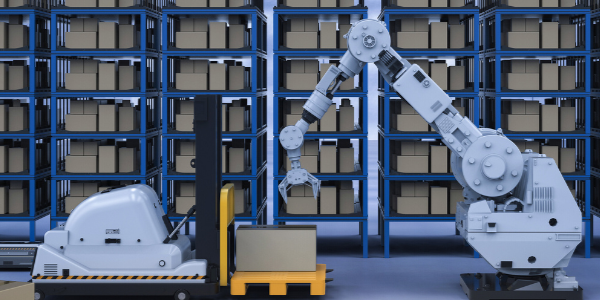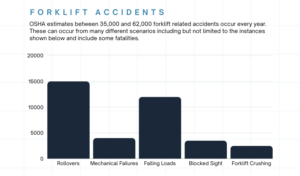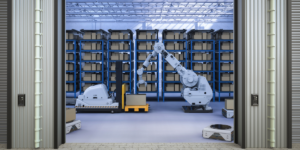
The Benefits of Telematics in Forklift Management
The integration of advanced technologies has become essential for optimizing efficiency, safety, and cost-effectiveness. Among these technologies, telematics stands out as a transformative solution, especially for managing forklift operations in the supply chain. Telematics can enhance efficiency, boost safety, and deliver substantial cost savings. From real-time monitoring and collision avoidance to reduced fuel consumption and streamlined operations, telematics can transform your business and catapult you into the future.
Understanding Telematics
Telematics, in its broadest sense, involves the use of telecommunications and informatics to send, receive, and store information related to remote objects, like industrial equipment. In the context of forklift operations, telematics systems gather and transmit data regarding the location, movement, and status of forklifts, providing real-time insights into their operation. This technology integrates GPS tracking, onboard diagnostics, and wireless communication, forming a robust framework for monitoring and managing fleet operations.

Improving Efficiency with Fleet Telematics
Real-Time Monitoring and Data Collection
One of the primary advantages of telematics in forklift operations is the ability to monitor and collect data in real-time. Fleet telematics systems provide detailed information about each forklift’s usage patterns, including hours of operation, idle times, and routes taken within the warehouse or worksite. This data can be analyzed to identify inefficiencies, such as excessive idling or suboptimal routing, allowing managers to make informed decisions to enhance operational efficiency.
Optimized Routing and Task Assignment
Telematics for fleet management facilitates the optimization of routing and task assignments. By analyzing the real-time location and status of each forklift, the system can assign tasks to the nearest available vehicle, reducing travel time and improving overall productivity. This ensures that forklifts are utilized effectively, minimizing downtime and maximizing throughput.
Preventative Maintenance
Efficient maintenance is crucial for the smooth operation of forklifts. Telematics systems track key performance indicators and diagnostic information, alerting managers to potential issues before they lead to breakdowns. By scheduling preventative maintenance based on actual usage and condition rather than fixed intervals, companies can significantly reduce the risk of unexpected failures, ensuring that forklifts remain in optimal working condition and avoid costly disruptions.
Enhancing Safety through Telematics Systems
Operator Behavior Monitoring
Safety is paramount in warehouse, manufacturing, and distribution operations, and telematics plays a crucial role in promoting safe practices. Telematics systems monitor operator behavior, recording instances of harsh braking, rapid acceleration, and other unsafe actions. This data can be used to identify operators who may need additional training or intervention, fostering a culture of safety within the workforce.
Collision Avoidance and Proximity Alerts
Advanced telematics systems incorporate features such as collision avoidance and proximity alerts. These systems use sensors to detect obstacles and other vehicles in the vicinity of the forklift, providing real-time warnings to operators. By preventing collisions and near-misses, these systems significantly reduce the risk of accidents, protecting both personnel and equipment.

Access Control and Authorization
Telematics systems can also enhance safety by implementing access control and authorization mechanisms. Only trained and authorized personnel can operate the forklifts, reducing the risk of accidents caused by inexperienced operators. This not only ensures compliance with safety regulations but also promotes a safer working environment.
Cost Savings through Telematics for Fleet Management
Reduced Fuel Consumption
Telematics systems contribute to cost savings by optimizing power consumption. By analyzing data on forklift usage, routes, and idle times, managers can implement strategies to minimize power wastage. For example, reducing idle times and optimizing routing can lead to significant power savings, translating to lower operational costs.
Extended Equipment Lifespan
Regular maintenance and timely repairs, facilitated by telematics systems, can extend the lifespan of forklifts. By addressing issues promptly and ensuring that equipment is well-maintained, companies can avoid premature wear and tear, reducing the need for frequent replacements. This leads to substantial cost savings in the long term.
Lower Insurance Premiums
Insurance companies often offer reduced premiums to businesses that implement telematics systems. The enhanced safety features and improved operational practices resulting from telematics usage lower the risk of accidents and claims. As a result, companies can benefit from lower insurance costs, contributing to overall cost savings.
Enhanced Inventory Management
Effective inventory management is critical in warehouse and industrial settings. Telematics systems provide valuable insights into the movement and storage of goods, enabling more accurate tracking and management of inventory. By reducing errors and improving inventory turnover, companies can optimize their stock levels and reduce holding costs.
Mix Telematics: Integrating Forklifts with Other Industrial Assets
Comprehensive Fleet Management
Mix telematics refers to the integration of telematics systems across different types of assets within an operation. In forklift operations, this involves connecting forklifts with other equipment, such as cranes, scissor lifts, and automated guided vehicles (AGVs). This comprehensive approach to fleet management enables a holistic view of the entire operation, facilitating better coordination and efficiency.
Unified Data Analytics
Mix telematics provides a unified platform for data analytics, consolidating information from various assets. This holistic view allows managers to identify trends, correlations, and opportunities for improvement across the entire operation. By leveraging data from different sources, companies can make more informed decisions and implement strategies that optimize their entire workflow.
Access Control Group offers AssetPro 360, an advanced IIoT (Industrial Internet of Things) business intelligence platform that harnesses data from your equipment fleet. It processes this operational information into actionable analytics and comprehensive reports, empowering you to make smarter decisions for optimizing resources. It seamlessly integrates with ERP and maintenance management software, eliminating the need for manual data entry and enabling you to make more informed decisions for optimizing resources.

The Future of Telematics in Forklift Operations
Integration with IoT and AI
The future of telematics in forklift operations lies in its integration with other advanced technologies, such as the Internet of Things (IoT) and artificial intelligence (AI). IoT-enabled sensors can provide even more granular data on forklift performance and environmental conditions, while AI algorithms can analyze this data to predict maintenance needs, optimize routing, and enhance safety measures.
Enhanced Connectivity and Integration
Future telematics systems will offer enhanced connectivity and integration capabilities, allowing seamless communication between different assets, systems, and stakeholders. This will enable more dynamic and responsive operations, where changes in one part of the workflow can instantly trigger adjustments in other areas, ensuring optimal performance and adaptability.
Telematics has emerged as a game-changer in forklift operations, offering a host of benefits that enhance efficiency, safety, and cost savings. Through real-time monitoring, optimized routing, preventative maintenance, and enhanced safety features, telematics systems enable companies to achieve higher levels of productivity and operational excellence. The integration of forklifts with other assets through mix telematics further streamlines operations, providing a unified platform for comprehensive fleet management. As telematics technology continues to advance, the future promises even greater innovations, including IoT integration, AI-driven analytics, and autonomous forklifts, all of which will further revolutionize forklift operations. Embracing telematics is not just a technological upgrade; it is a strategic move towards a safer, more efficient, and cost-effective future in supply chain operations.
The integration of advanced technologies is crucial for optimizing efficiency, safety, and cost-effectiveness. The ADVANCED Telematics System is a powerful solution, particularly for fleet management. This system enhances efficiency, improves safety, and delivers significant cost savings for enterprise rental fleets. With real-time monitoring, preventative maintenance alerts, and streamlined operations, the ADVANCED Telematics System can revolutionize your fleet management, propelling your business into the future. Discover how you can take control of your operations with the ADVANCED Telematics System by contacting Access Control Group today.
